Excerpts from Jim Conrad's
Naturalist Newsletter
from the November 16, 2018 Newsletter issued from Rancho Regenesis in the woods ±4kms west of Ek Balam Ruins; elevation ~40m (~130 ft), N20.876°, W88.170°; north-central Yucatán, MÉXICO
ORGANICALLY GROWN ROSELLE/ JAMAICA
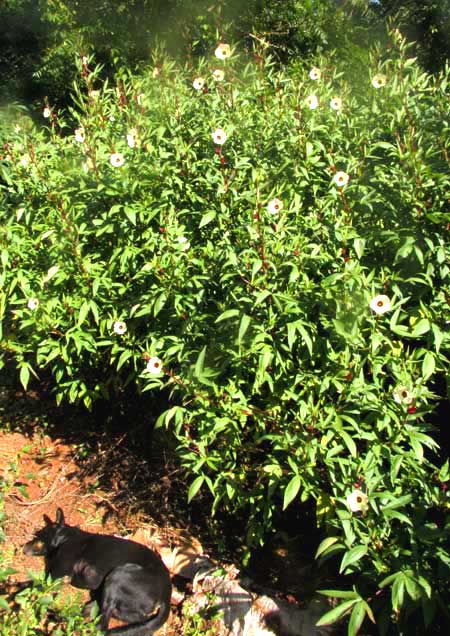
Back just before the rainy season began, in April or so, our neighbor Don Solís brought us a bag of Roselle seeds. He grows Roselle commercially, using chemicals. We wanted to try growing it organically.
Here Roselle is known as Jamaica, pronounced "ha-MY-ca." It's HIBISCUS SABDARIFFA, thus a true hibiscus, one native to the Old World tropics. For centuries the plant has been famous for the teas and food dishes prepared from its flowers' acid, fleshy calyxes. This is another of those plants introduced into the Americas by Europeans 500 years ago, after which America's tropical indigenous people incorporated it into their own traditional cuisine. Down here Jamaica tea is very popular, even sold in bottles in supermarkets. In the US, maybe it's best known as the main ingredient in Red Zinger herbal tea.
I didn't know anything about growing Roselle, but the Internet is full of information. With a pickax I broke up our cow-hoof-compacted clay soil, mixed in plenty of composted cow and burro manure, and planted my seedlings one meter apart (3.3ft). Because Roselle is closely related to Okra and was reported to grow even taller than Okra, and Okra doesn't need that much space, one meter seemed too far apart. However, once the Roselle plants reached their fastest growing period, soon I began thinking that maybe they needed more than a meter. At the top of this page you can see the dense wall of Roselle plants as they are now, standing about 3m tall (10ft), with Negrita the medium-size dog providing scale
Some visitors before the plants began flowering thought that the plants' growth form and leafshape suggested Marijuana plants. However, Roselle's leaves are mostly three-lobed, while Marijuana's leaves consist of up to eleven slender leaflets. A typical Roselle leaf is shown below:
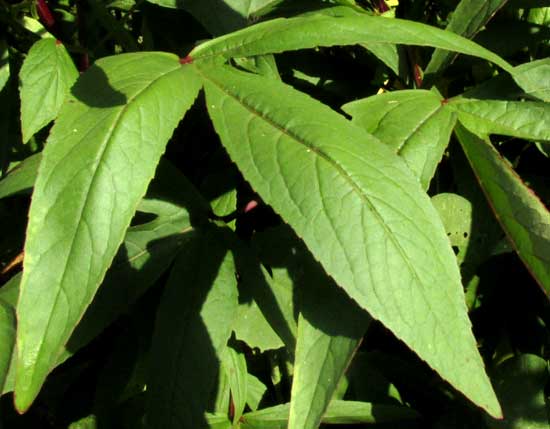
The Roselle flower with its large, bell-shaped, dark-centered corolla surrounding many stamens with their filaments fused into a cylinder encircling the style couldn't look any more hibiscusy, as you can see below:
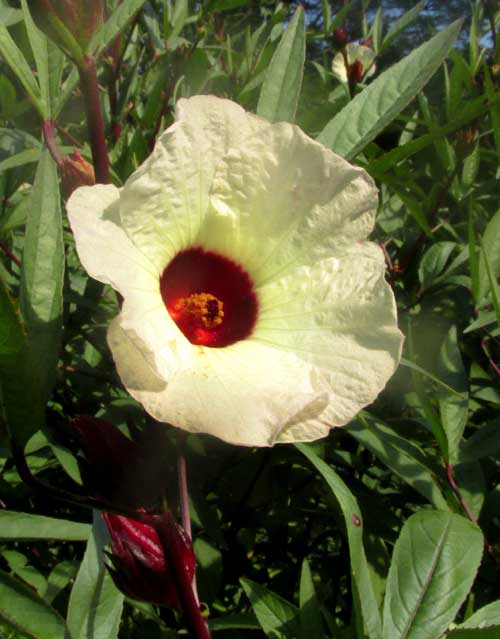
A rear view of a flower, showing that the corolla's base arises from a five-toothed, purple calyx, and that the calyx itself issues from a cuplike "involucre" consisting of several slender, sharp-pointed "bracts," which are modified leaves, is seen below:
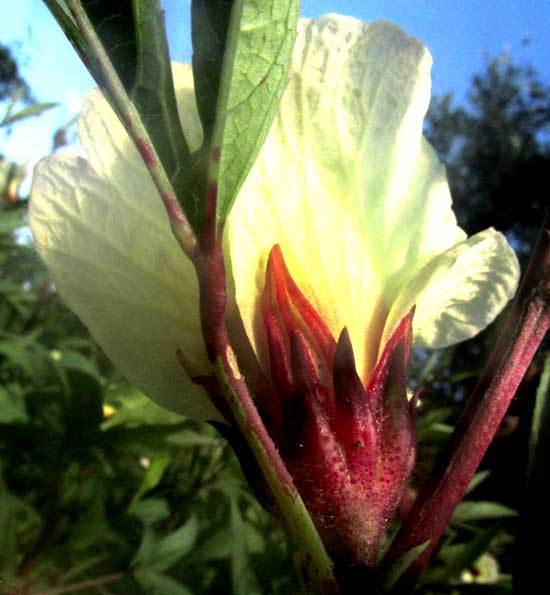
It's the calyxes needed for brewing tasty teas, but in the above picture the calyx is almost hidden by the involucre. Removing a few involucral bracts reveals the calyxes' swollen glands, seen below:
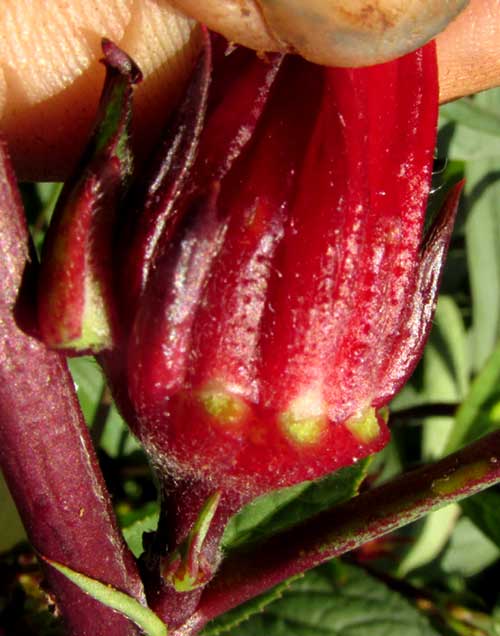
The three greenish spots at the calyx's bottom show where bracts were removed. Above each bract there's an elongated, round-topped, dark purple, acid-filled, gland. With time the glands increase in size dramatically. My plants have just begun flowering.
The main reason the plants take up so much room is that they branch robustly from their semi-woody bases, and those branches also branch. While holding a plant's outer branches apart, I got a shot of the interior branching, shown below:
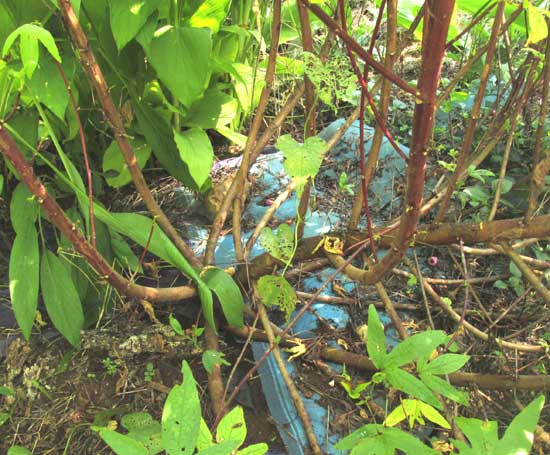
Though our Roselle flowers are destined mostly for providing Jamaica tea for visitors to Genesis in Ek Balam, the hotel operated by the ranch's owner, tea making is just one option for the acid-filled sepals. From them you can prepare jam, jelly, marmalade, candies, syrups and sauces.
For one of my own meals I chopped up whole flowers, including the green ovaries, sauteed them with onion, garlic, chili pepper and tomato, and scrambled them with two eggs. A few young leaves were added, contributing a mild lemony flavor. The meal was OK but I think the flowers were too young to produce much taste, for the dish was a bit bland.
Later I brewed 15 whole young flowers along with their maturing ovaries. The resulting tea, providing only a cup of tea, tasted like Jamaica tea, but also there was a "corncob taste," apparently produced by the maturing ovaries. It seems there's no shortcut to having just the sepals needed for the tea. The flowers will have to be dried, then the sepals removed from each flower individually, which will be a real task.
You've seen that my Roselle planting created a dense wall. Rows of Roselle plants can be used in permaculture as windbreaks and barriers.
Now that I've decided that it's a waste of flowers to use them too early, according to literature produced by commercial growers in neighboring Quintana Roo, the main harvest will take place later, probably toward the end of December. I read that the plants are highly sensitive to day length, so their flowering and fruiting is not controlled by water availability or temperature. For the harvest, the entire plants will be cut and dried, then the flowers removed, then the calyxes removed individually from the flowers. We'll see how that goes.
from the November 30, 2018 Newsletter issued from Rancho Regenesis in the woods ±4kms west of Ek Balam Ruins; elevation ~40m (~130 ft), N20.876°, W88.170°; north-central Yucatán, MÉXICO
ROSELLE/ JAMAICA CALYXES EXPANDING
During the last two weeks the sepal-bearing calyxes of the early-blooming flowers profiled above have expanded greatly, as you can see below:
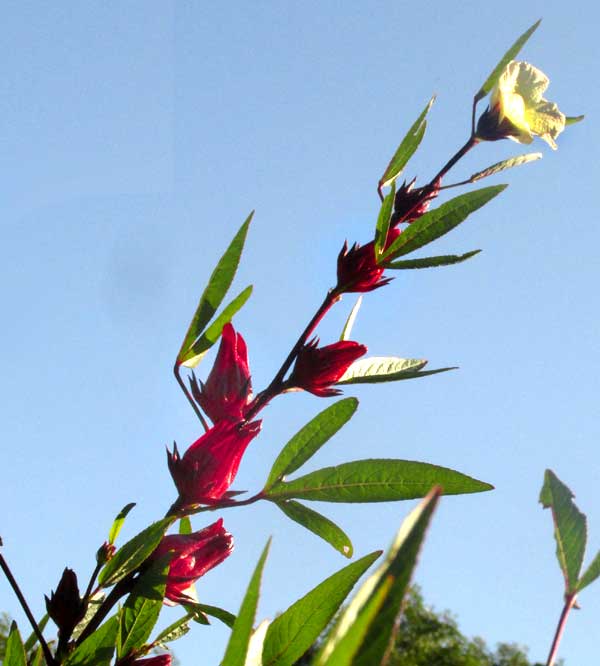
In that picture a new flower is opening at the top, right. Below that blossom, the corollas have already fallen from the flowers. The lower the remaining calyxes are on the stem, the earlier their flowers opened, and the larger their calyxes have grown. An older calyx with its sepals bulging with acid-filled grands is shown below:
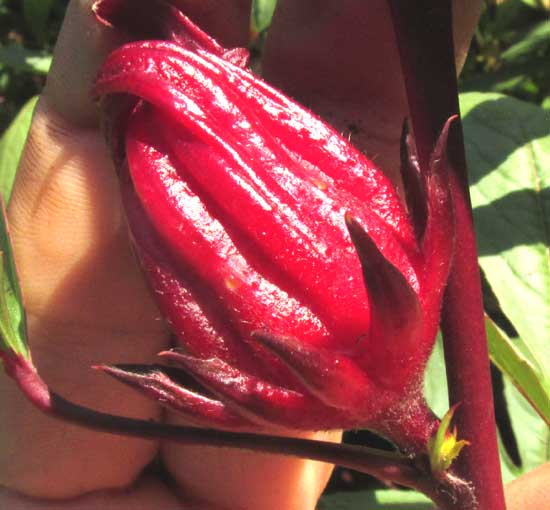
from the December 14, 2018 Newsletter issued from Rancho Regenesis in the woods ±4kms west of Ek Balam Ruins; elevation ~40m (~130 ft), N20.876°, W88.170°; north-central Yucatán, MÉXICO
HARVESTING ROSELLE/JAMAICA CALYXES
When the dry season began a month or so ago, I began watering the plants regularly. However, soon the plants' lower leaves started drying up and falling off. I read that Roselles respond not to temperature changes and water availability, but rather to photoperiod, or the relative lengths of days and nights. In the Northern Hemisphere at this time of year the days are growing shorter, and at our latitude during early November Roselle decides to start dropping its leaves and put all its energy into enlarging and maturing its calyxes. By the first of December our plants' slender, mostly leafless limbs were bending beneath their heavy crops of fleshy calyxes, as seen below:
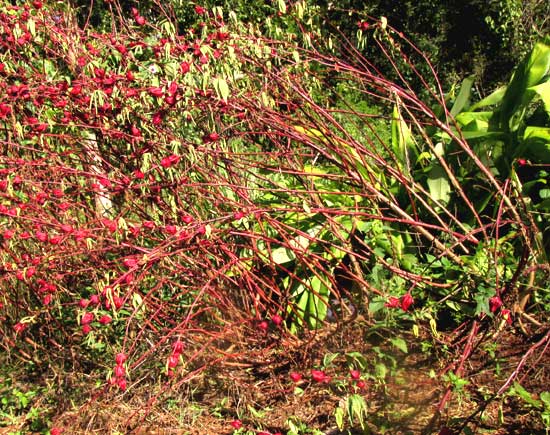
I've read that harvesting the calyxes should begin when about half the plants' leaves have fallen, but I waited until later because our calyxes kept growing every day. This week the harvest began by snipping off the ends of calyx-bearing branches, as shown below:
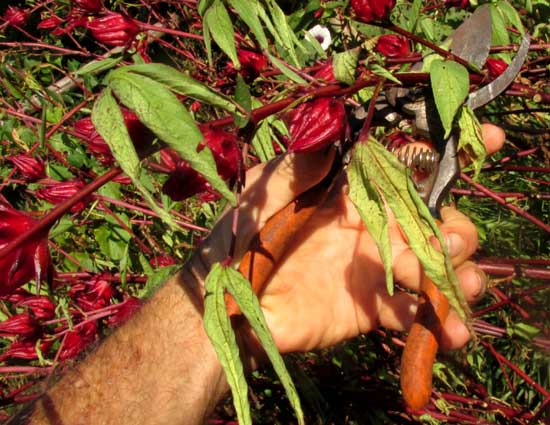
A box filled with the snipped-of, calyx-bearing tips of a single Roselle bush is shown below:
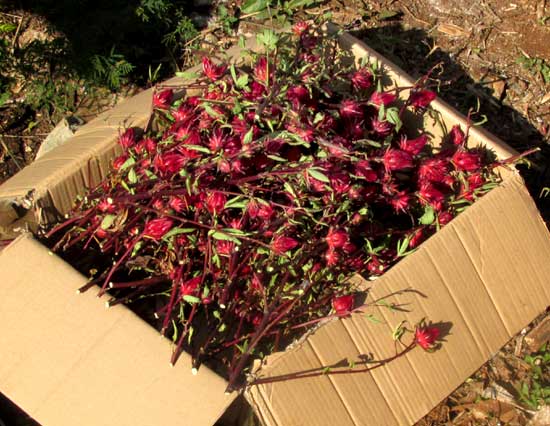
The surprising manner in which that first harvested bush spread its side-branches so broadly is shown in a picture below, of the pulled-up, pruned plant being held by volunteer gardener Eric from Colorado, superintended by Katrina the dog:
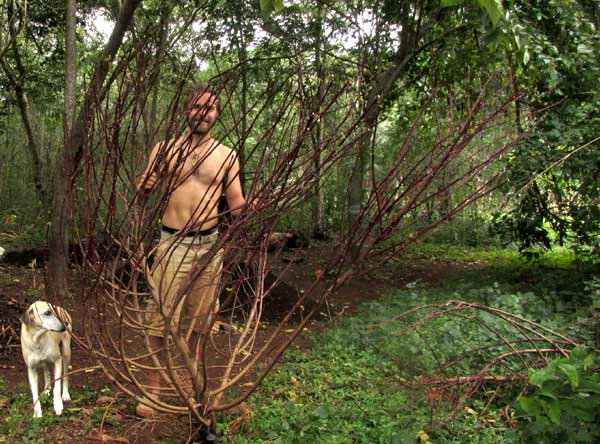
After the branches were snipped off, each calyx had to be removed from its stem section individually. Various ideas for speeding up the process were tried but in the end nothing went faster than simply cutting them off with the same snippers used duringn the stem-cutting photograph. A perfect removed calyx, its glands engorged with flavorful acids of various kinds, subtended by a star-shaped collection of succulent bracts, and enclosing the flower's immature capsular fruit, is shown below:
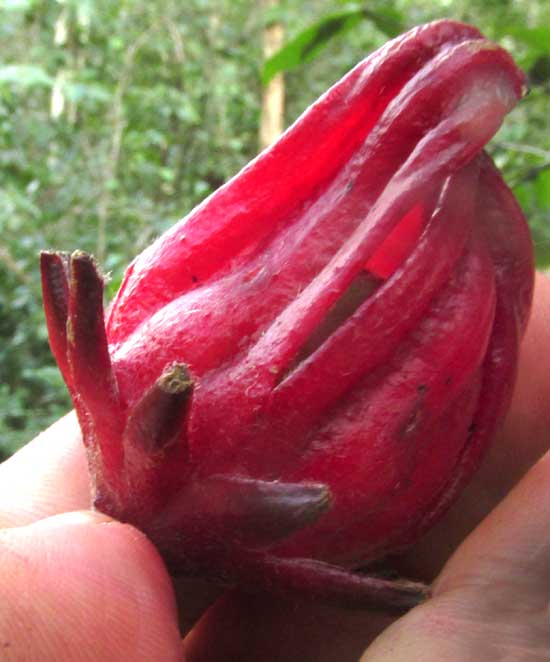
Now came the most time-consuming part, that of removing the calyxes from around the acorn-sized fruits. Eric from Colorado is shown below busily doing this next to a box filled with the harvest from the single first bush:
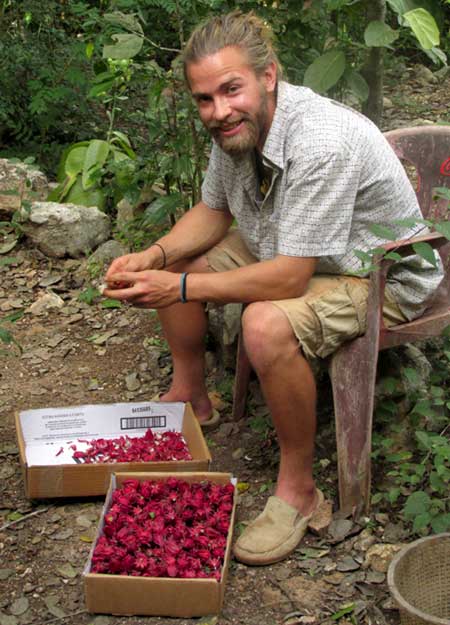
The question arose as whether the slender bracts beneath the calyx should be removed. The bracts were fleshy and tasted as flavorful and acidy as the calyx, so we kept them on.
Finally came the drying, which is ongoing. Below, you can see our fancy drier beside a resplendent Bougainvillea:
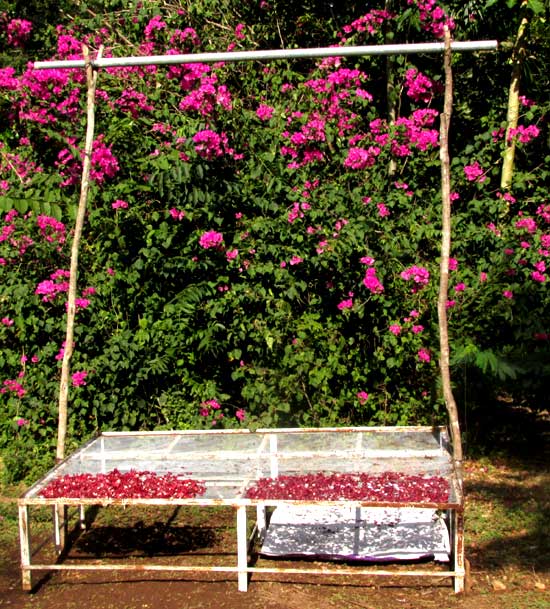
There some freshly laid-out sepals are shown at the left, while the slightly darker ones at the right -- those from the first bush -- have had about half a day of drying in the sunlight. I read that three days of tropical sunlight are needed to produce properly dried sepals. Below, the freshly laid-out sepals are shown close up:
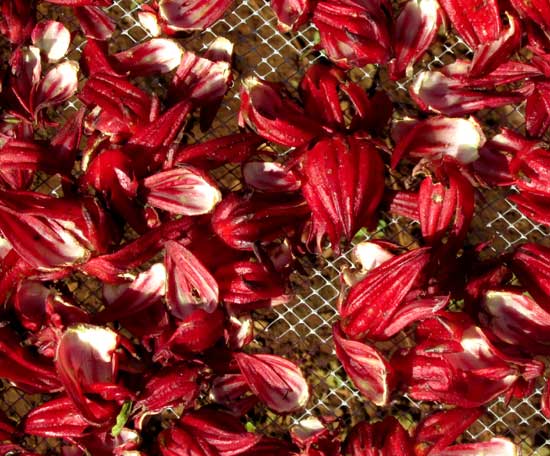
Surprisingly, the second bush harvested -- the second from the end of the row where we started -- was only about half the size and half as productive as the first one. The third bush produced even less. Since all the plants grew in soil prepared the same way and received the same amounts of water and sunlight, I think that the inside bushes suffered from being too close together. I'd read that they needed to be a meter apart (3.3ft) but having started with such small seeds and seedlings I could hardly believe that, and settled for about 0.9 meter (3ft). Now I think that for maximum production they should have been at least 1.3 meters apart, maybe 1.5.
I hope that our next Newsletter installment concerning the Roselles will show how a delicious tea is brewed from our own plants.